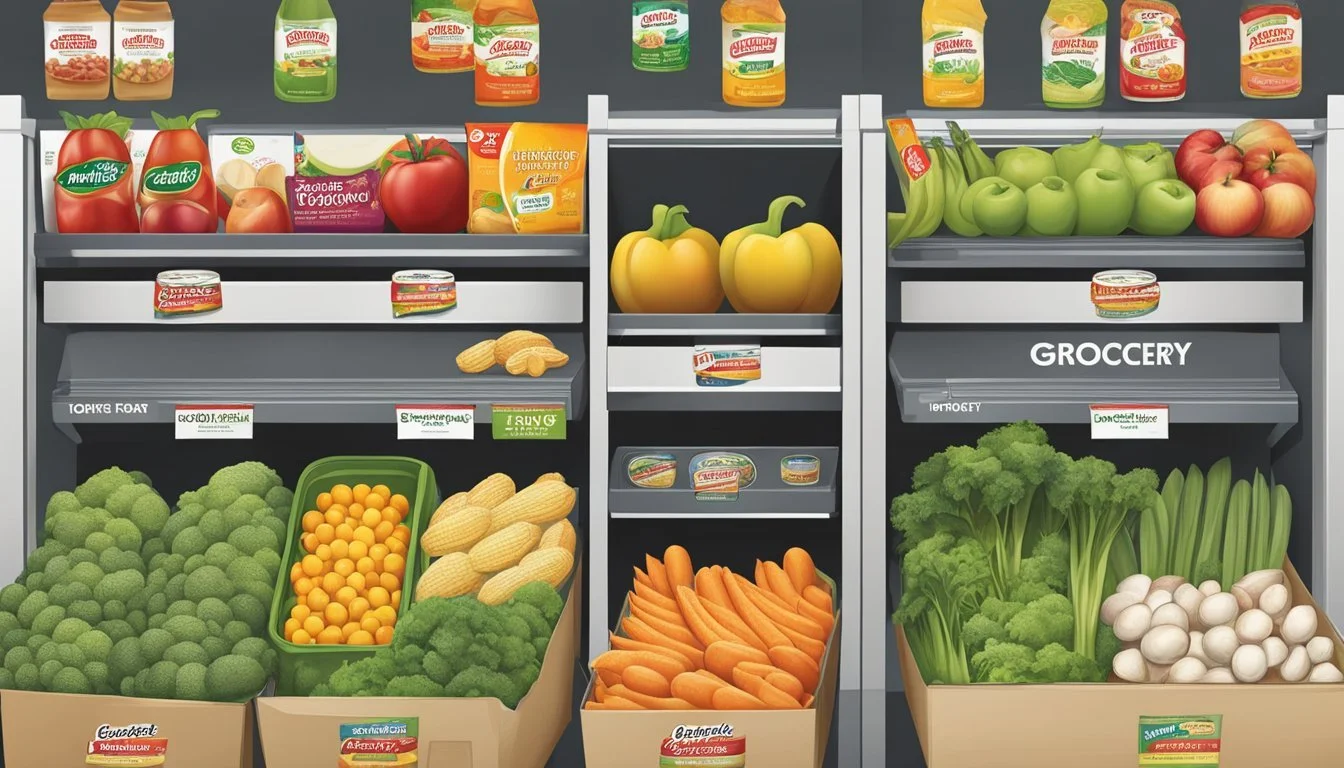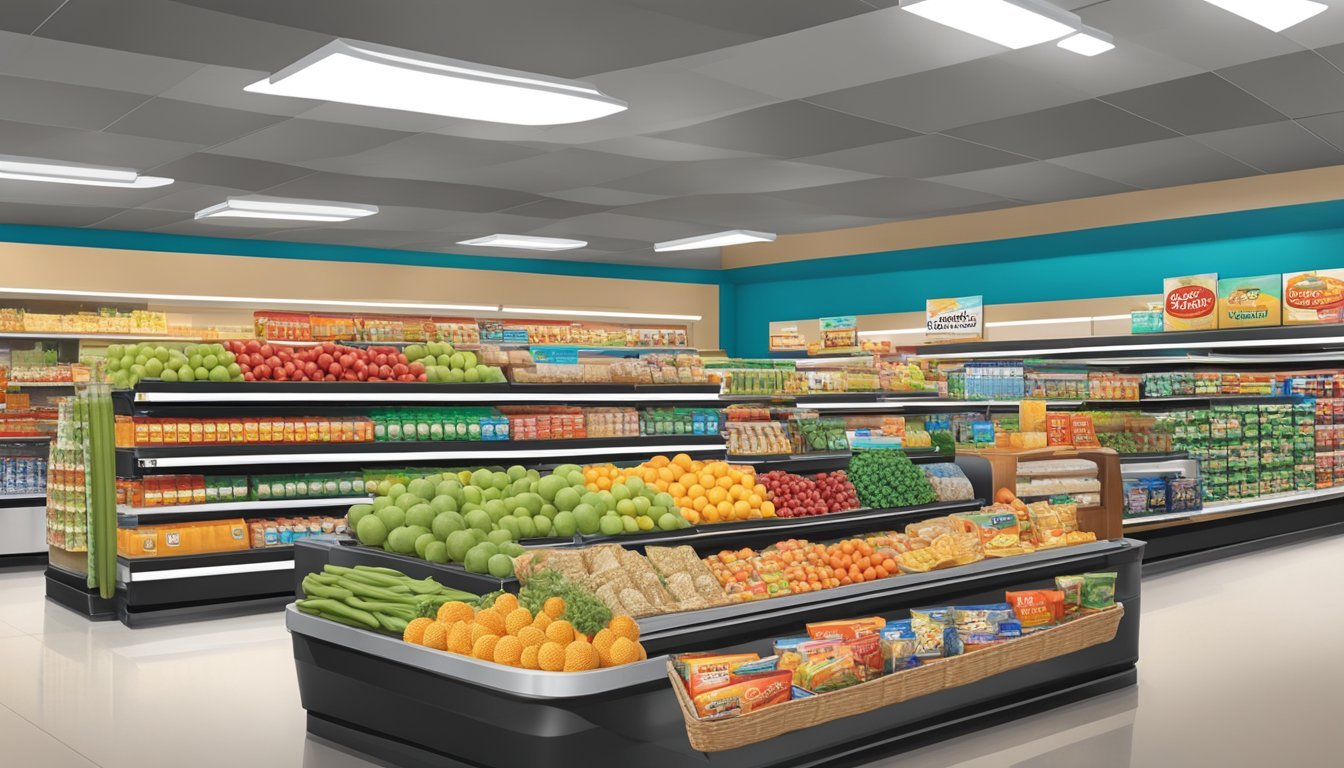Is Brookshire Grocery Company Cheaper Than Grocery Outlet?
A price comparison of two popular supermarkets
Grocery shopping can be a significant expense for many households, making it essential to find stores that offer the best value for money. Brookshire Grocery Company and Grocery Outlet are two popular options for budget-conscious shoppers, but which one provides better prices?
Based on available data, Grocery Outlet generally offers lower prices compared to Brookshire Grocery Company. Grocery Outlet's business model of selling surplus and discounted national-brand products allows them to provide steep discounts, with prices estimated to be about 27% below average grocery store prices.
While Brookshire Grocery Company is known for its customer service and community involvement, it may not always match the rock-bottom prices found at Grocery Outlet. The trade-off often comes in the form of a more consistent product selection at Brookshire's versus the ever-changing inventory at Grocery Outlet. Shoppers looking to maximize savings might find Grocery Outlet more appealing, but those who value a predictable shopping experience may prefer Brookshire's.
Overview of Brookshire Grocery Company
Brookshire Grocery Company is a prominent regional supermarket chain with a rich history and diverse business model. The company operates hundreds of stores across multiple states and offers various retail formats to serve different customer needs.
History and Expansion
Brookshire Grocery Company was founded by Wood T. Brookshire in Tyler, Texas in 1928. From a single store, the company grew steadily over the decades. Today, Brookshire's operates more than 200 stores across Texas, Louisiana, Arkansas, and Oklahoma. The company remains family-owned, maintaining its commitment to community values while expanding its reach.
Brookshire's has diversified its retail offerings over time. In addition to its flagship Brookshire's stores, the company launched Super 1 Foods, Spring Market, and FRESH by Brookshire's. These different store formats cater to varying customer preferences and market segments.
Business Model and Services
Brookshire Grocery Company focuses on providing quality products and excellent customer service. The company operates four main retail brands:
Brookshire's: Traditional supermarkets
Super 1 Foods: Value-oriented stores
Spring Market: Smaller format neighborhood stores
FRESH by Brookshire's: Upscale, gourmet-focused locations
To support its retail operations, Brookshire's maintains several distribution centers. These facilities ensure efficient supply chain management and product delivery to stores across the four-state region.
The company's headquarters remain in Tyler, Texas, where it was founded. Brookshire's is known for its strong community involvement, often participating in local events and charitable initiatives in the areas it serves.
Review of Grocery Outlet
Grocery Outlet offers significant savings through its unique discount retail model. The company has expanded rapidly across the United States, particularly in California.
Expansion and Operations
Grocery Outlet operates over 400 stores across the United States. The company began in California and has since spread to other states, including Oregon, Washington, Idaho, Nevada, and Pennsylvania. Each store is independently owned and operated by local families, creating a connection to the community.
Grocery Outlet's expansion strategy focuses on entering new markets and increasing store density in existing areas. The company aims to open 50-60 new stores annually. This growth has allowed Grocery Outlet to compete with traditional supermarket chains while maintaining its discount pricing model.
Discount Retail Model
Grocery Outlet's business model revolves around offering brand-name products at discounted prices. The company achieves this by purchasing surplus inventory, closeouts, and overstock items from manufacturers and distributors. This approach allows them to sell products at up to 70% off retail prices.
The store's inventory changes frequently, creating a "treasure hunt" shopping experience. Customers can find a mix of staple items and unexpected deals. Grocery Outlet carries approximately 30,000 products, including fresh produce, meat, deli items, and non-food merchandise.
Grocery Outlet's pricing strategy appeals to budget-conscious shoppers seeking quality products at lower costs. The company's ability to offer significant savings has contributed to its growth and popularity among consumers looking to stretch their grocery budgets.
Comparative Price Analysis
Brookshire Grocery Company and Grocery Outlet differ in their pricing strategies, product selections, and regional presence. These factors impact overall affordability for shoppers.
Average Price Metrics
Grocery Outlet consistently offers lower prices compared to many competitors. Their prices are typically 27% below the average of surveyed stores. Brookshire's prices tend to be higher, with one comparison showing they were 10% more expensive than Walmart for a basket of 32 items.
Grocery Outlet achieves these savings through a unique business model. They sell surplus and overstock name-brand products at steep discounts. This leads to an ever-changing inventory but significant savings for customers.
Brookshire's operates more like a traditional grocery chain. Their regular prices are often higher, but they offer weekly sales and promotions to attract budget-conscious shoppers.
Product Range and Quality
Grocery Outlet's inventory is less predictable due to its surplus-focused model. Shoppers may find high-quality, name-brand items at deep discounts. However, selection can vary greatly from week to week.
Brookshire's offers a more consistent product range. They stock a full selection of groceries, including fresh produce, meat, and bakery items. This reliability comes at a higher average price point.
Quality at Grocery Outlet can be excellent for packaged goods, as they often sell the same brands found in mainstream stores. Fresh produce quality may be more variable.
Brookshire's maintains consistent quality across departments. They focus on providing a full-service grocery experience, which is reflected in their pricing.
Region-Specific Pricing
Grocery Outlet operates primarily in the western United States. Their prices remain competitive across their locations due to their discount model.
Brookshire's is a regional chain focused in Texas, Louisiana, and Arkansas. Prices may vary slightly between locations based on local competition and operating costs.
In areas where both stores operate, Grocery Outlet typically offers lower prices on comparable items. However, Brookshire's may be more competitive on certain product categories or during promotional periods.
Local economic factors and competition from other chains like Walmart can influence pricing strategies for both companies in specific regions. Shoppers may find the best value by comparing weekly ads and taking advantage of store-specific promotions.
Products and Selection
Brookshire Grocery Company and Grocery Outlet offer distinct product selections and quality levels. Their offerings cater to different customer preferences and shopping needs.
Produce and Meat Quality
Brookshire's provides a wide range of fresh produce and meats. Their stores feature well-stocked produce sections with seasonal fruits and vegetables. The company sources from local farmers when possible, ensuring freshness.
Brookshire's meat department offers various cuts of beef, pork, and poultry. They often have in-store butchers for custom cuts.
Grocery Outlet's produce and meat selection can be more limited. Their stock varies based on surplus availability. Quality can be inconsistent, but prices are often lower.
Private Labels and Generic Staples
Brookshire's offers its own private label brands across multiple categories. These include TopCare for health and beauty, Food Club for pantry staples, and Full Circle for organic options.
Grocery Outlet carries a changing assortment of brand-name products at discounted prices. They have fewer consistent private labels but offer steep discounts on overstock items.
Both stores carry basic generic staples like flour, sugar, and canned goods. Brookshire's selection tends to be more stable, while Grocery Outlet's inventory fluctuates based on available deals.
Customer Experience
Brookshire Grocery Company and Grocery Outlet offer distinct customer experiences. Each retailer focuses on different aspects to attract and retain shoppers.
Checkout Process and Convenience
Brookshire Grocery Company emphasizes a smooth checkout process. The stores feature multiple lanes and self-checkout options to reduce wait times. Many locations offer grocery delivery services, catering to busy families and individuals who prefer shopping from home.
Grocery Outlet takes a different approach. Their stores typically have fewer checkout lanes, which can lead to longer lines during peak hours. However, the company compensates with a no-frills shopping environment that appeals to bargain hunters. Grocery Outlet does not offer delivery services at most locations, focusing instead on in-store experiences.
Loyalty Programs and Discounts
Brookshire Grocery Company operates a robust loyalty program. Customers can earn points on purchases, which translate into discounts on future shopping trips. The company also offers digital coupons and personalized deals through its mobile app.
Grocery Outlet does not have a traditional loyalty program. Instead, they focus on consistently low prices and rotating inventory. This approach attracts bargain-seeking consumers who enjoy the "treasure hunt" aspect of finding unexpected deals. Grocery Outlet's lack of a formal loyalty program is offset by its everyday low prices and frequent sales.
Both retailers cater to price-conscious shoppers, but through different strategies. Brookshire's rewards loyal customers over time, while Grocery Outlet aims to provide immediate savings on each shopping trip.
Fiscal Responsibility and Community Impact
Brookshire Grocery Company demonstrates a strong commitment to fiscal responsibility and community impact. The company's approach balances financial prudence with substantial investments in local economies and charitable initiatives.
Economic Impact on Local Communities
Brookshire Grocery Company operates over 200 retail stores across Texas, Louisiana, Arkansas, and Oklahoma. This extensive network creates significant job opportunities, employing thousands of local residents. The company's presence stimulates local economies by generating tax revenue and supporting regional suppliers.
Brookshire's expansion efforts often target underserved areas, bringing fresh food options to communities lacking grocery stores. This strategy addresses food deserts while fostering economic growth. The company's distribution centers also contribute to regional economic development, creating additional jobs and supporting local infrastructure.
As a family-owned business, Brookshire reinvests profits into store improvements and new locations, further bolstering local economies. This approach reflects the company's long-term commitment to the regions it serves.
Charity and Community Service
Brookshire Grocery Company prioritizes giving back to its communities through various charitable initiatives. The company donates to organizations supporting hunger relief, education, health, and family wellbeing. These efforts help address critical social needs in the areas where Brookshire operates.
The company's community involvement extends to supporting first responders, military personnel, and veterans. This commitment reflects Brookshire's core values and recognition of community heroes. Employee-partners often participate in volunteer activities, reinforcing the company's local presence.
Brookshire's charitable programs include food drives, scholarship funds, and disaster relief efforts. These initiatives demonstrate the company's responsive approach to community needs. By integrating social responsibility into its business model, Brookshire strengthens its ties with customers and enhances its reputation as a community-focused retailer.
Strategic Industry Position
Brookshire Grocery Company and Grocery Outlet operate in distinct segments of the retail grocery market. Their contrasting strategies and target demographics shape their competitive positions.
Market Trends and Competitor Analysis
Brookshire Grocery Company competes primarily as a traditional supermarket chain in regional markets. With over 150 stores across Texas, Louisiana, and Arkansas, it faces competition from larger national chains and local independents. The company's focus on customer service and community involvement helps differentiate it in smaller markets.
Grocery Outlet, in contrast, operates as a discount grocery retailer. Its business model revolves around offering deeply discounted products through opportunistic buying and a no-frills shopping experience. This positions Grocery Outlet to attract price-sensitive consumers and compete with discount chains and dollar stores.
Both companies must navigate industry trends like increasing online grocery sales and demand for organic and specialty products. Brookshire's has responded by expanding its e-commerce offerings, while Grocery Outlet maintains a primarily in-store model.
Leadership and Corporate Strategy
Brad Brookshire leads Brookshire Grocery Company as CEO, continuing the family's multi-generational involvement. The company employs approximately 19,000 people and emphasizes employee development and promotion from within. This strategy aims to maintain a consistent culture and operational expertise.
Brookshire's corporate strategy focuses on steady growth in its core markets. The company has expanded through acquisitions of regional chains and the development of new store formats like FRESH by Brookshire's. This multi-format approach allows it to target different customer segments.
Grocery Outlet pursues an aggressive expansion strategy, rapidly increasing its store count through a franchise model. This approach allows for faster growth with lower capital requirements. The company's leadership focuses on maintaining its unique sourcing model and empowering local operators to tailor inventory to their markets.
Conclusion
Comparing Brookshire Grocery Company and Grocery Outlet reveals differences in pricing strategies and product offerings. Grocery Outlet often provides deeper discounts on brand-name items through its opportunistic buying model. Brookshire, as a regional chain, focuses on consistent pricing and local connections.
Product selection varies between the two stores. Grocery Outlet carries a rotating inventory of around 30,000 items, while Brookshire maintains a more stable product lineup. This impacts the shopping experience and ability to find specific items regularly.
Pricing at both stores can be competitive, but in different ways. Grocery Outlet excels in sporadic deals on name brands. Brookshire offers everyday low prices and weekly specials, particularly on store brands and fresh produce.
Location plays a role in accessibility and overall cost comparisons. Brookshire operates primarily in Texas, Louisiana, Arkansas, and Oklahoma. Grocery Outlet has a wider geographic presence, potentially making it more accessible to some shoppers.
Ultimately, determining which store is cheaper depends on individual shopping habits, preferred products, and local market conditions. Savvy consumers may find value in shopping at both stores to maximize savings on different types of groceries.









